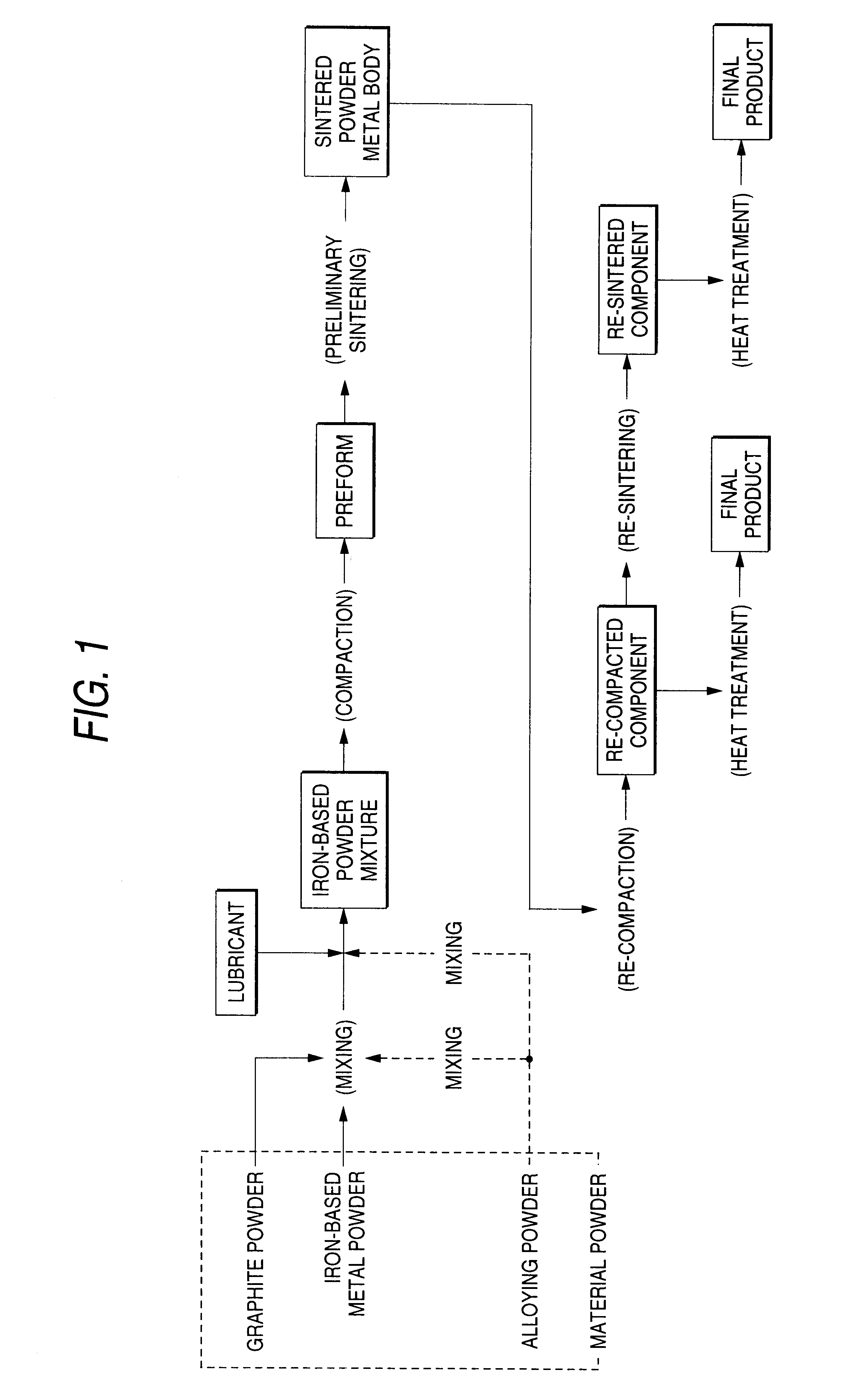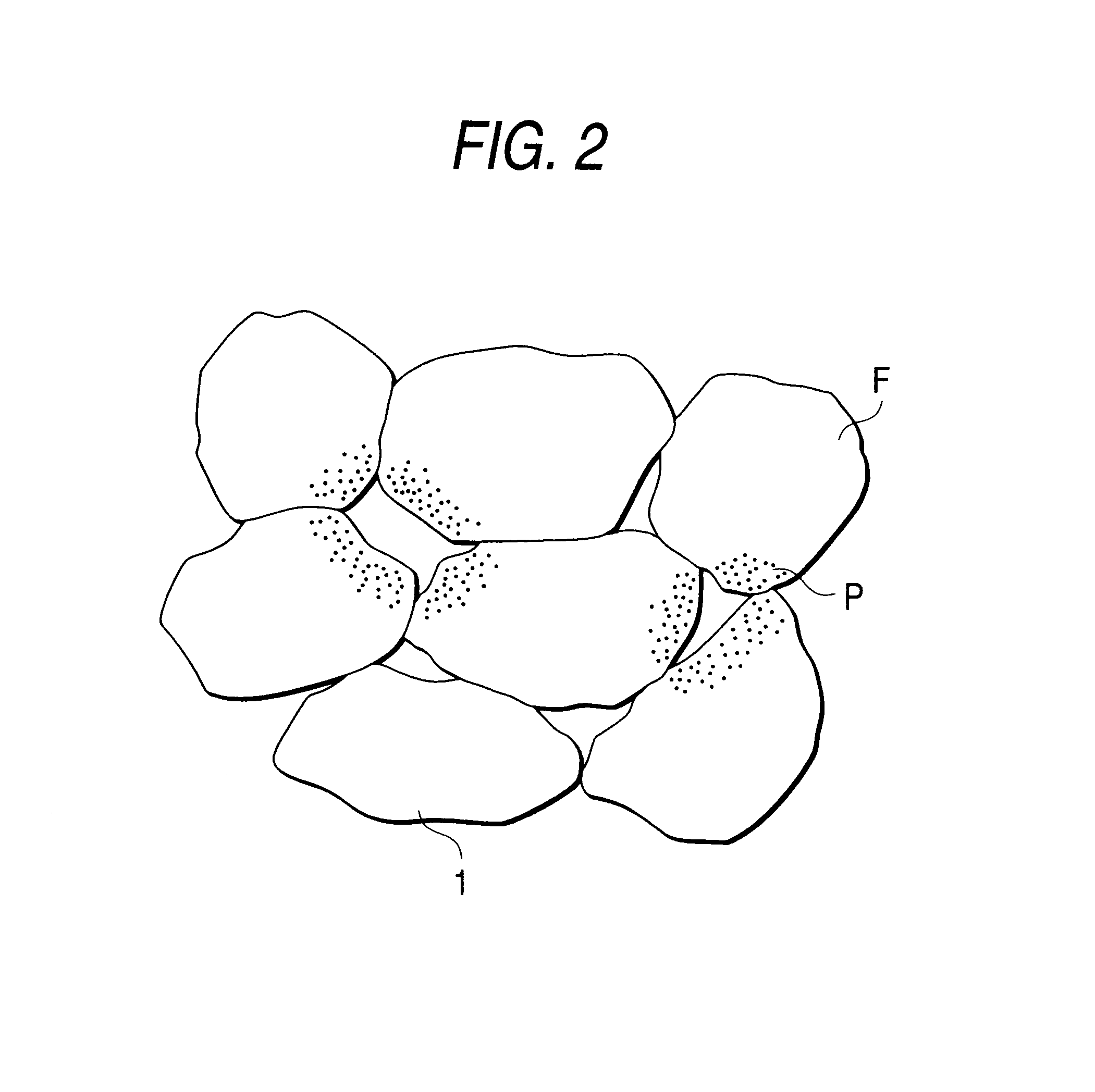Iron-based sintered powder metal body, manufacturing method thereof and manufacturing method of iron-based sintered component with high strength and high density
a technology of iron-based sintered components and metal bodies, which is applied in the direction of metal-working apparatuses, transportation and packaging, etc., can solve the problems of reducing the dimensional accuracy of the component, not being fabricated into the desired shape, and increasing production costs
- Summary
- Abstract
- Description
- Claims
- Application Information
AI Technical Summary
Benefits of technology
Problems solved by technology
Method used
Image
Examples
example 1
Graphite powders and lubricants of the kinds and the contents shown in Table 1 were mixed to iron-based metal powders shown in Table 1 by a V-mixer to form iron-based powder mixtures.
For the iron-based metal powder, an iron powder A (KIP301A, manufactured by Kawasaki Steel Corporation) and a partially alloyed steel powder B were used. The iron powder A used in this example (Specimen Nos. 1-1 to 1-13, 1-15 to 1-19, 1-22 and 1-23) had an average grain size of about 75 .mu.m, and contained 0.007 mass % C, 0.12 mass % Mn, 0.15 mass % of O and 0.0020 mass % of N and the remainder of Fe and inevitable impurities. As the impurities, 0.02 mass % Si, 0.012 mass % S and 0.014 mass % P were contained. The partially alloyed steel powder B was formed by mixing 0.9 mass % of a molybdenum oxide powder to the iron powder A, keeping the same at 875.degree. C..times.3600 s in a hydrogen atmosphere, and diffusion bonding molybdenum partially on the surface. The partially alloyed steel powder B had a c...
example 2
Graphite powders and lubricants of the kinds and the contents shown in Table 3 were mixed to iron-based metal powders shown in Table 3 by a corn-type mixer to form iron-based powder mixtures.
For the iron-based metal powder, a partially alloyed steel powder C formed by partially alloying Ni and Mo on the surface of iron powder A particles through the same process as in Example 1 was used. The composition of the partially alloyed steel powder C contained 0.003 mass % C, 0.08 mass % Mn, 0.09 mass % O, 0.0020 mass % N, 2.03 mass % Ni and 1.05 mass % Mo. Further, natural graphite was used for the graphite powder and one of zinc stearate, lithium stearate and ethylene bisstearoamide was used as the lubricant. In Table 3, the content of the lubricant in the iron-based powder mixture is indicated by parts by weight based on 100 parts by weight for the total amount of the iron-based metal powder and the graphite powder.
The iron-based mixed powder was charged in a die, compacted at the room t...
example 3
Graphite powders and lubricants of the kinds and the contents shown in Table 5 were mixed to iron-based metal powders shown in Table 5 by a corn-type mixer to form iron-based powder mixtures.
For the iron-based metal powder, a pre-alloyed steel powder D formed by a water atomizing method (KIP5MOS, manufactured by Kawasaki Steel Corporation) was used. The composition of the pre-alloyed steel powder D comprised 0.004 mass % C, 0.20 mass % Mn, 0.11 mass % 0, 0.0021 mass % N and 0.60 mass % Mo and the remainder of Fe and inevitable impurities. As the imparities, 0.02 mass % Si, 0.006 mass % S and 0.015 mass % P were contained. The average particle size of the powder D was about 89 .mu.m. Further, natural graphite was used for the graphite powder and zinc stearate was used for the lubricant.
In Table 5, the content of the lubricant in the iron-based powder mixture is indicated by parts by weight based on 100 parts by weight in total for the iron-based metal powder and the graphite powder.
T...
PUM
| Property | Measurement | Unit |
|---|---|---|
| pressure | aaaaa | aaaaa |
| temperature | aaaaa | aaaaa |
| temperature | aaaaa | aaaaa |
Abstract
Description
Claims
Application Information
 Login to View More
Login to View More - R&D
- Intellectual Property
- Life Sciences
- Materials
- Tech Scout
- Unparalleled Data Quality
- Higher Quality Content
- 60% Fewer Hallucinations
Browse by: Latest US Patents, China's latest patents, Technical Efficacy Thesaurus, Application Domain, Technology Topic, Popular Technical Reports.
© 2025 PatSnap. All rights reserved.Legal|Privacy policy|Modern Slavery Act Transparency Statement|Sitemap|About US| Contact US: help@patsnap.com


